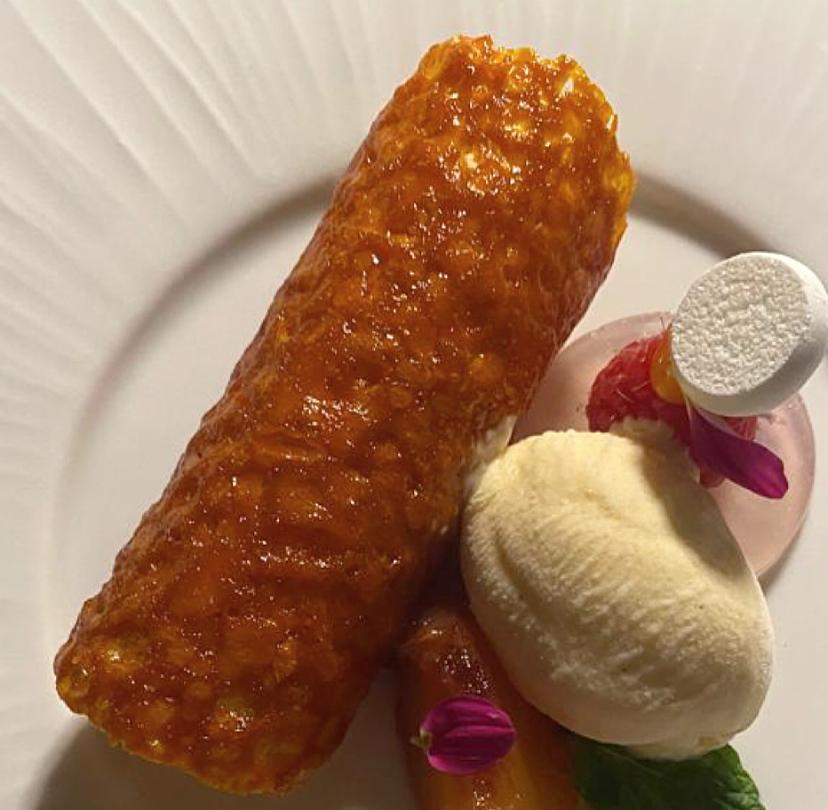
The de Mondion Restaurant
- The Xara Palace, Misrah il-Kunsill, Mdina MDN 1050, Malta
- 2145 0560
- info@xaracollection.com
- Website
Mdina. It’s quite hard to beat Mdina as your dinner location, the sky dark, with night flickers of stars and moon, the narrow limestone walls faintly lit by the dim warm light from the lamp posts, you’re heading to the old council square, you’re excited, your expectations are high and you maybe even get butterflies. That thrill; it’s called the de Mondion effect.
Dining at The de Mondion Restaurant, housed in the Xara Palace in Mdina is a culmination of all the priceless things in life. The walk through the old city, the receptionist’s greeting at the hotel entrance and the antiquity in architecture that creates a home for a menu so elevated and perfected; yet rooted in the fine art of culinary mastery.
Chef Kevin Bonello adorned us with plate after plate of bravura and affetti, a masterpiece tasting menu that imbues the magnitude of his culinary wizardry, seen through refreshed lenses, tailored to the wants, needs and desires of the local palate. These dishes were the vortex to addiction, a state of being where you’re craving something you didn’t even know you needed in your life. The Local Imtahleb Snails, is a utopian representation of Malta’s pinnacle of culinaria.
The seven-course tasting menu that we were honoured to be present for on the night of our visit, was a performance of bravado and emotion. The wine pairing that we landed on was a Ta’ Betta voyage from a smokey oak fermented Chardonnay; the tenacious Jean Parisot, to the luscious red, in all its opulence; the blend of Merlot and Cabernet Sauvignon taking the latter part of our meal to a swift step into paradise – the Antonio Manoel.
We did however start off the meal with a fine Negroni, recommended as an aperitif, and gratefully suggested. A large, wet, slow-melting, rock ice – an essential bartender trick that reduces the effects of dilution, sat in my glass as I swished the Campari, vermouth and gin, gazing out onto the captivating view from Mdina’s hilltop. Faint lights in the distance give the restaurant a cosmopolitan vibe, seen through the eyes of a tranquil yet engaged setting around an elegant round table.
The table was met with an amuse bouche of snacks from the kitchen – and as you may have realised, a favourite feature of mine for spews of creativity, daring adventure and avant garde concepts. These did not disappoint.

Beef Tartare (Photo: Nina Cassar Dowling)
The Beef Tartare came served on a tapioca cracker, the perfect bitesize hit of crisp and tanginess to start off your meal. The Smoked Eel, came on a squid cracker providing a sweet and subtle finish and the Caviar and Cream offering a delicious richness in texture, both crispy and creamy; empowered by fragrant and elegant flavours.

Caviar and Cream (Photo: Nina Cassar Dowling)
Every taste bud was activated right from the start, the astringent bitterness from the Negroni, the salty sweetness from the squid ink, the tanginess of the beef tartar and the texture of the tapioca, the crispiness from the wafer and the smoothness of the cream – it was all there. Not so much spiciness – but the meal didn’t tap into this umami heavily throughout.
The Bread Course featured good olive oil, butter and a selection of house-made breads. A palate cleanser that welcomed our first glass of Jean Parisot.

Bread Course (Photo: Nina Cassar Dowling)
Direct from the Xara Gardens, the opening dish, second on the tasting menu, was an elegantly prepared beetroot dish, shaved thin, retaining a firm bite and consistent thickness, rolled into a base and topped with a sheep cheese ice-cream, buddha’s hand, bitter-sweet in flavour and the perfect seasoning for this dish.

Xara Gardens ‘Bull’s Blood’ Beetroot (Photo: Nina Cassar Dowling)
The rooty earthiness of the beetroot, albeit sweet in flavour, is rather robust, giving the citron buddha’s hand a perfect base to bounce off of. The sheep cheese coldness and distinct aroma is prevalent in the overtones of the dish, pairing so excellently with beetroot – but given a different dimension though temperature tampering. The addition of perfection – nuttiness and texture served through the roasted hazelnuts. Hats off.
A pasta course is a great way of deciphering the pillars of a Chef. Which way does their cooking technique sway? How do they modernise a classic? What edits will they make to a dish? It’s quite exciting. A simple Sugo Nero is transformed into an unveiling of something new.
The Taglioni is fresh and salty, with a citrus note that runs through it mysteriously. The cuttle fish adds texture and sweetness, which works with that zesty aroma, the sea urchin bisque is rich and fragrant while the marjoram adds an earthiness to the overall olfactory experience. You’re presented this dish concealed with a klose to ensure you’re thoroughly surprised by the presentation… yes, perhaps, but primarily to lock in a smoke that infused a deep bold flavour, picked up even at the very end of the dish.

Tagliolini (Photo: Nina Cassar Dowling)
There’s always a dish in every Chef’s repertoire that serves as a nod to childhood, an ode to a memory or maybe an interpretation of a feeling. Chef Kevin Bonello’s Local Imtahleb Snails is a perfect representation of that innocence and admiration that it takes to be an inspiring Chef.
Breaking each element down as an individual feature is tough, because no matter how meticulously it was built for its plating, this dish just begged to be incorporated as a whole and savoured wholly. There are moments when dining for a review, where your non-professional self wants to pounce at your plate of food – but for the sake of analysis and savouring every flavour, this is a custom reserved for home dining. I must say, this was one of the hardest dishes to resist diving head first into.
The snails were tender and rich – meaty and hearty with notes of earthiness reinforced with the ras el hanut seasoning chosen for this memorable plate. The fresh lightly wilted spinach that sat atop the snails was a nice cut to the richness that was added on in leaps and bound with the decadent hen’s yolk that ran through the entire dish so smoothly.

Local Mtaħleb Snails (Photo: Nina Cassar Dowling)
The artichoke puree, an intermediary between earthy and luscious, provided a buffer between the egg and the greens. A herby and smooth finish rounded things off gracefully. Tasting this dish was a privilege.
The final feature of our savoury stream of succulence was the pinnacle of the meal. It’s clear why this dish is saved till the very end. The skin is luscious and the meat is tender – what more could you ask for in a suckling pig?

Suckling Pig (Photo: Nina Cassar Dowling)
Unlike the ultra crispy pork skin you would achieve on a porchetta, or a pork belly cut, the skin texture on a suckling pig should be moist, tender and bursting with sweet sticky juices melting from the collagen in the protein. The chew gives stature and the flavour additions of Piccalilli, seen in the pickled onion bulbs, mustard sauce and dates coated and fried to the perfect crunch created a palatable combination of umami, richness and acid. And just to make things extra – truffle shaving for a deep woody element. The breathing point on this dish – the subtleness of the chard.
To turn the palate onto its sweet alerts, a Watermelon and Sea Buckthorn served with gazpacho, yoghurt and elderflower was a vibrant palate twister. A two-part dish that featured a watermelon and sea buckthorn drink, a mixologist’s concoction of sweet and fresh, paired with tangy and astringent. A wonderful way to recharge your electrolytes and hydrate after a lush meal of rich ingredients.

Watermelon and Sea Buckthorn (Photo: Nina Cassar Dowling)
The second element of this pre-dessert was an aerated yoghurt scoop with spheres of apple, radish, pineapple, cucumber and melon – implying that every bite will be different in texture and taste – a true palate cleanser that brushed away the complexities of the savoury portion of the meal.
The grand finish was the Kannol – Chef Bonello’s interpretation, that is. A sophisticated, up-scale version of the classic. Incorporating crunch, fruit, texture, bite and creaminess – all covered in a gloss finish. There’s nothing matt in this dish, it glistens as the light, crisp shell cracks under the slight pressure of your dessert spoon. A cold, Gran Marnier ice-cream oozing out, cooling the palate and refreshing the senses. The addition of meringues adds another hint of texture, as does the gel from a contrary angle. Infused with peach essence, the playfulness of the gel takes the Bajtra liqueur hinted in the cannolo shell to a new height. Tartness features with the raspberry, as the mint leaves boost the dish with their pick-me-up agenda.

“Kannol” (Photo: Nina Cassar Dowling)
We closed the meal with a wholesome encounter with Chef Kevin, as we sampled the petit fours bursting with passion fruit textured Autumn Leaves, a full-flavoured Raspberry Jelly and a duo of chocolate wonders; a crisp-shelled Praline and a nutty and buttery Malacov.
Those high expectations we galloped in with, were met. Exceeded and will be celebrated again.

Kristina Cassar Dowling
HORECA Reviews are based on the experience of the diners on their particular visit. The nature of these reviews is based on the publication’s expertise in the industry, but also highlights the reviewer’s opinions and preferences. The aim of HORECA Reviews is to showcase culinary talent, to give the hospitality industry insight on their patron’s experience and areas for improvement as well as to celebrate the strive for excellence within the sector.

